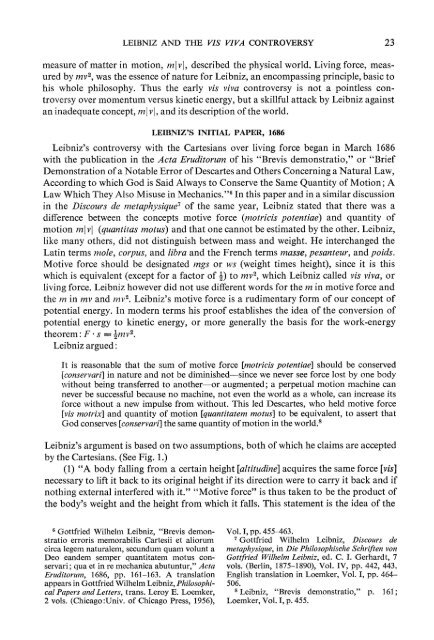Leibniz and the Vis Viva Controversy
Leibniz and the Vis Viva Controversy
Leibniz and the Vis Viva Controversy
Create successful ePaper yourself
Turn your PDF publications into a flip-book with our unique Google optimized e-Paper software.
LEIBNIZ AND THE VIS VIVA CONTROVERSY 23<br />
measure of matter in motion, MnI vj, described <strong>the</strong> physical world. Living force, measured<br />
by mV2, was <strong>the</strong> essence of nature for <strong>Leibniz</strong>, an encompassing principle, basic to<br />
his whole philosophy. Thus <strong>the</strong> early vis viva controversy is not a pointless controversy<br />
over momentum versus kinetic energy, but a skillful attack by <strong>Leibniz</strong> against<br />
an inadequate concept, ml vI, <strong>and</strong> its description of <strong>the</strong> world.<br />
LEIBNIZ'S INITIAL PAPER, 1686<br />
<strong>Leibniz</strong>'s controversy with <strong>the</strong> Cartesians over living force began in March 1686<br />
with <strong>the</strong> publication in <strong>the</strong> Acta Eruditorum of his "Brevis demonstratio," or "Brief<br />
Demonstration of a Notable Error of Descartes <strong>and</strong> O<strong>the</strong>rs Concerning a Natural Law,<br />
According to which God is Said Always to Conserve <strong>the</strong> Same Quantity of Motion; A<br />
Law Which They Also Misuse in Mechanics."6 In this paper <strong>and</strong> in a similar discussion<br />
in <strong>the</strong> Discours de metaphysique7 of <strong>the</strong> same year, <strong>Leibniz</strong> stated that <strong>the</strong>re was a<br />
difference between <strong>the</strong> concepts motive force (motricis potentiae) <strong>and</strong> quantity of<br />
motion ml vl (quantitas motus) <strong>and</strong> that one cannot be estimated by <strong>the</strong> o<strong>the</strong>r. <strong>Leibniz</strong>,<br />
like many o<strong>the</strong>rs, did not distinguish between mass <strong>and</strong> weight. He interchanged <strong>the</strong><br />
Latin terms mole, corpus, <strong>and</strong> libra <strong>and</strong> <strong>the</strong> French terms masse, pesanteur, <strong>and</strong> poids.<br />
Motive force should be designated mgs or ws (weight times height), since it is this<br />
which is equivalent (except for a factor of 2) to mV2, which <strong>Leibniz</strong> called vis viva, or<br />
living force. <strong>Leibniz</strong> however did not use different words for <strong>the</strong> m in motive force <strong>and</strong><br />
<strong>the</strong> m in mv <strong>and</strong> mv2. <strong>Leibniz</strong>'s motive force is a rudimentary form of our concept of<br />
potential energy. In modern terms his proof establishes <strong>the</strong> idea of <strong>the</strong> conversion of<br />
potential energy to kinetic energy, or more generally <strong>the</strong> basis for <strong>the</strong> work-energy<br />
<strong>the</strong>orem: F * s = -mv2.<br />
<strong>Leibniz</strong> argued:<br />
It is reasonable that <strong>the</strong> sum of motive force [motricis potentiae] should be conserved<br />
[conservari] in nature <strong>and</strong> not be diminished-since we never see force lost by one body<br />
without being transferred to ano<strong>the</strong>r-or augmented; a perpetual motion machine can<br />
never be successful because no machine, not even <strong>the</strong> world as a whole, can increase its<br />
force without a new impulse from without. This led Descartes, who held motive force<br />
[vis motrix] <strong>and</strong> quantity of motion [quantitatem motus] to be equivalent, to assert that<br />
God conserves [conservari] <strong>the</strong> same quantity of motion in <strong>the</strong> world.8<br />
<strong>Leibniz</strong>'s argument is based on two assumptions, both of which he claims are accepted<br />
by <strong>the</strong> Cartesians. (See Fig. 1.)<br />
(1) "A body falling from a certain height [altitudine] acquires <strong>the</strong> same force [vis]<br />
necessary to lift it back to its original height if its direction were to carry it back <strong>and</strong> if<br />
nothing external interfered with it." "Motive force" is thus taken to be <strong>the</strong> product of<br />
<strong>the</strong> body's weight <strong>and</strong> <strong>the</strong> height from which it falls. This statement is <strong>the</strong> idea of <strong>the</strong><br />
6 Gottfried Wilhelm <strong>Leibniz</strong>, "Brevis demonstratio<br />
erroris memorabilis Cartesii et aliorum<br />
circa legem naturalem, secundum quam volunt a<br />
Deo e<strong>and</strong>em semper quantitatem motus conservari;<br />
qua et in re mechanica abutuntur," Acta<br />
Eruditorum, 1686, pp. 161-163. A translation<br />
appears in Gottfried Wilhelm <strong>Leibniz</strong>, Philosophical<br />
Papers <strong>and</strong> Letters, trans. Leroy E. Loemker,<br />
2 vols. (Chicago:Univ. of Chicago Press, 1956),<br />
Vol. I, pp. 455-463.<br />
7 Gottfried Wilhelm <strong>Leibniz</strong>, Discours de<br />
metaphysique, in Die Philosophische Schriften von<br />
Gottfried Wilhelm <strong>Leibniz</strong>, ed. C. I. Gerhardt, 7<br />
vols. (Berlin, 1875-1890), Vol. IV, pp. 442, 443.<br />
English translation in Loemker, Vol. I, pp. 464-<br />
506.<br />
8 <strong>Leibniz</strong>, "Brevis demonstratio," p. 161;<br />
Loernker, Vol. I, p. 455.
















